


Today's smaller military force performs force projection missions on a global scale, against an unpredictable threat. Warfighters depend on space-based technologies to provide command and control communications, to employ high-technology sensors and weapon systems, and to access the vast array of realtime intelligence and information that provides decisive advantage for mission success.
Over the past two decades military satellite communications systems have become increasingly important to our ability to project force and conduct military operations around the globe. Rapidly growing information requirements and the increasing unpredictability of who and where we may fight, make our satellite communications systems more critical every day. Military needs are diverse and require a mixture of satellite communications services to support wartime operations. This mixture includes the use of the military frequency bands as well as augmentation from commercial communications satellites. We must also look to evolving satellite communications capabilities such as global broadcast service, personal communications service, and bandwidth on demand to meet tomorrow's warfighter requirements.
Military and commercial satellite communications systems, tied seamlessly into the terrestrial infrastructure, must provide assured and survivable communications on demand, on the move, and around the globe.
The design of a responsive future architecture, with the right mix of military and commercial satellite capabilities, must be based on critical analysis of all requirements. Warfighter requirements are paramount to the design of future space support capabilities.
Superior satellite communications are absolutely essential to fight and win on the modem day battlefield. We must act now to ensure that our near-term needs and emerging requirements are recognized, documented and reflected in a responsive, integrated, and affordable architecture to support our armed forces well beyond the turn of the century.

JOSEPH W. ASHY
General, USAF
Commander, Air Force Space Command
INTRODUCTION

This handbook, the first of a two-volume series, grew out of a tasking to develop education materials for satellite communications (SATCOM) users. Space-based communications systems provide vital capabilities to successfully execute the National Military Strategy and implement the Command, Control, Communications, Computers, and Intelligence (C4I) for the Warrior concept.
Global force projection is a complex task. Success hinges on the ability to effectively synchronize joint force combat power within the battlespace, and respond rapidly to the warfighter's information requirements, such as just-in-time intelligence, logistics, and other support from the sustaining base. Emerging information requirements will add to capacity demands on communications systems. The timely delivery of imagery, video, and large data files is a high volume information dissemination requirement that demands a solution. Military and commercial SATCOM, tied seamlessly into the terrestrial infrastructure, is critical to meet these warfighter requirements for assured and survivable communications on-demand, on-the-move, and around the globe.
The purpose of this handbook is to:
SPACE AND THE NATIONAL MILITARY STRATEGY

A primary mission of U.S. military forces is to credibly deter and, if required, decisively defeat aggression by major regional powers. To accomplish this mission, we must be able to project power anywhere in the world, at any time, to deter and defeat enemies threatening the vital interests of the United States and its allies.
Today's smaller military force performs this force projection mission on a global scale, against unpredictable threats. Limited strategic lift, available for the projection of tailored combat forces, creates the need for split-based operations, i.e., reliance on a sustaining base for many of the support capabilities once a part of the deployed force package. To compensate for these operational disadvantages, warfighters depend on space-based technologies to provide command and control communications, to employ high-technology sensors and weapons systems, and to access the vast array of real-time intelligence and information that provides decisive advantage for mission success.
Space-based capabilities such as communications, intelligence collection and dissemination, targeting, warning, weather, and position location, combine to provide essential support to military operations across the joint battlespace. Space-based systems, integrated with the terrestrial C4I infrastructure, provide critical capabilities for warfighter execution of joint land, sea, and air operations.
SPACE AND THE JOINT BATTLESPACE

The C4I for the Warrior concept establishes a clear vision and strategy for achieving a fully integrated, fused, realtime true representation of the Joint Battlespace. The capability of the warrior to respond and coordinate horizontally and vertically to prosecute effectively and successfully any mission in the battlespace is the essence of the C4I for the Warrior concept. Space systems provide a crucial and essential means to achieve the joint warfighter's immediate battle management, intelligence, warning, and combat support information requirements. Terrestrial line-of-sight radio systems have limited range and tether the commander to terrain and limit mobility and maneuverability. Only space systems provide the commander the means to synchronize maneuver of forces throughout the battlespace.
Warfighters synchronize battlespace operations using voice, data, imagery, and video information at low, medium, and high data rates. Battlespace information is exchanged at multiple levels of classification via several modes-broadcast, networked, switched, and dedicated (point-to-point). Deployed commanders must be able to exploit C4I capabilities within the battlespace, regardless of the limitations imposed by the existing theater infrastructure, while simultaneously denying the enemy the same capability. Information dominance, a critical combat multiplier, is the result.
Satellite Communications provide the warfighter with an immediately available, flexible information highway uniquely capable of supporting the global mission.
WARFIGHTER REQUIREMENTS FOR SATCOM
Warfighter requirements are paramount in the design of future space support capabilities. Warfighters need the following capabilities from space-based C4I systems:
The vision of the C4I for the Warrior concept is a broadly connected joint system of systems that provides total battlespace information. Space-based communications systems are a critical component of the overall global information infrastructure that supports the warfighter. Interoperability goals extend beyond the battlespace and warfighting systems.

The Defense Information System Network (DISN) is being designed to provide a transparent, seamless, and strategic interface between the terrestrial telecommunications infrastructure and spacebased C4I components. When complete, it will provide the warfighter easy access to a full range of military and commercial information resources and services designed to support joint land, sea, and air operations.
GLOBAL COVERAGE
Warfighters must have the capability to access C4I support from any location around the globe, including the polar regions. Recent experience has shown a high likelihood that U.S. forces will be engaged in concurrent regional conflicts. Only SATCOM systems can provide connectivity for continuous operations worldwide. SATCOM can accommodate (simultaneously) widely dispersed forces in various states of training, mobilization, deployment, engagement, sustainment, recovery, and redeployment.
Simultaneous Major Regional Contingencies
DoD SATCOM must support operational forces globally with a full range of services (regardless of location, dispersion or proximity of forces) while concurrently having sufficient flexibility to support two nearly simultaneous major regional contingencies.
Split-based Operations
The strategy of power projection requires warfighters to deploy into a theater of operations from diverse geographic locations. They must rely on bases outside the theater for many of the support capabilities that were once provided by the deployed forces. This split-based concept allows smaller force deployments but increases the commander's dependence on reliable, flexible, secure, high-capacity C4I to get critical intelligence and logistics information to and from the sustaining base.

In-Theater Operations
C4I networks are rarely static because combat operations are mobile and dynamic. Maneuver forces can rapidly outrun terrestrial C4I systems due to the tempo of combat operations. Within a theater, satellites link forces operating beyond radio line-of-sight that are unable, for whatever reason, to access the terrestrial C4I infrastructure.
Focus on Forces
Communications systems must support military forces regardless of terrain or distance. SATCOM systems must be flexible enough to dynamically adapt and refocus C4I capabilities, wherever needed, as forces deploy around the globe.
ASSURED, REAL-TIME ACCESS
Combat success requires timely transfer of critical orders and the dissemination of perishable information. Warfighters need assured, real-time access to SATCOM resources to exercise positive command and control, and to disseminate intelligence information during all operational phases. A warfighter's access to SATCOM must, therefore, be available on demand for the duration of the mission.

Offense is a fundamental principle of war; the combatant that obtains exploitable information first gains the initiative to move and shoot first. The warfighter's need for a real-time battlespace picture is closely linked to enabling technology. Assured, real-time access to SATCOM capabilities allows the joint warrior to collect and disseminate intelligence and orders rapidly enough to operate inside the enemy's decision cycle and to seize and retain the initiative.

CAPACITY
A warfighter's mission, and information transfer requirements derived from that mission, determine the demand for satellite capacity. Since operational requirements vary significantly across the spectrum of conflict, demands. for capacity will also change. Voice requirements are easily met at low data rates, while video and imagery requirements demand much higher data rates. C4I support must be flexible enough to satisfy all warfighter data rate needs (low, medium and high) on demand. No one system can yet provide this range of capabilities.
Ultrahigh frequency (UHF) satellite systems used by maneuver forces during Desert Storm provided excellent support for mobile combat operations, but were not designed for large data transfer requirements.
Super high frequency (SHF) terminals provided greater capacity, but were not mobile enough to support dynamic, fastpaced operations during the 100-hour ground war.
The planned extremely high frequency (EHF) Milstar constellation will not only satisfy low and medium data rate requirements, but will also be survivable against the full range of threats. However, emerging requirements demand even higher data rate capabilities for the dissemination of critical information such as video, imagery, intelligence, air tasking orders, and logistics, Direct broadcast satellite technology is one potential solution that shows great promise for satisfying many of these requirements.
An increased reliance on advanced technology to improve combat performance at all levels of war has significant implications for communications. The price of advanced technology is often a greater dependence on rapid, high volume information transfer. Future DoD SATCOM systems must employ the technology required to provide maximum capacity to forces, using small, highly mobile terminals.
PROTECTION
The United States must protect access to and use of space. "C4I for the Warrior - From Concept to Reality", promulgated in 1994 by the Chairman of the Joint Chiefs of Staff (CJCS), clearly expresses the need for protection of C4I systems from "actions that degrade the system components-people, procedures, communications paths, switches, hardware and software and the information itself."
Space-based communications systems provide the primary wartime information path to the deployed warfighter. Protection of this critical path, and the security of the information flowing through it, is vital to national security interests. Satellite capabilities have become so critical to every aspect of military operations, that they are a center of gravity and a prime target for potential enemies
Threats to satellite systems include jamming, interference, direction finding, interception, intrusion, physical attack, as well as ionospheric scintillation and other effects of nuclear explosions. Possible threats to satellite control communications links are also of concern. Most of these threats are viewed as intrinsic to the theater of military operations.
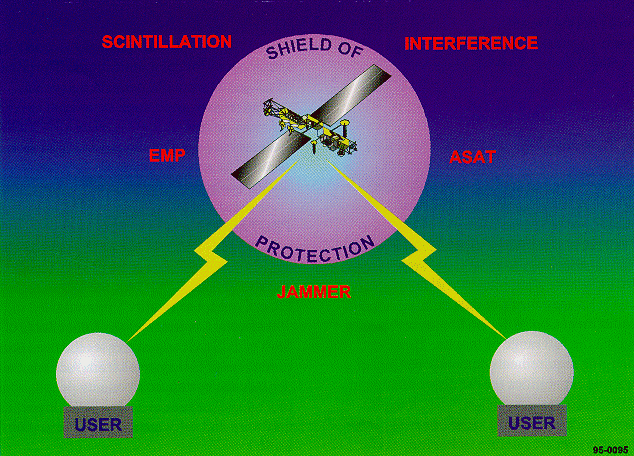
Military operations in the information age require a broader threat perspective. Information warfare now includes the potential of more insidious worldwide threats to military and commercial communications infrastructures from terrorists, foreign governments, computer hackers, and business competitors seeking economic or political gain. Non-DoD systems may also be susceptible to disruptions from political conflicts, civil or labor protests, power outages, or other reasons beyond DoD control. While traditional jamming and detection threats remain, these new threats are potentially as serious. They could occur anywhere and affect any portion of the infrastructure.
The warrior must now consider the information warfare vulnerability of all supporting C4I capabilities, and plan and implement protection solutions accordingly. Striking a balance between the need for protecting C4I capabilities and cost is a difficult but critical task. Clearly, some requirements may not require special protection. On the other hand, some C4I requirements are so critical that they must have robust protection from any or all of the threats listed above. For the warfighter, the need to protect specific C4I capabilities is derived from a careful risk assessment of the threat and the potential impact of that threat on the mission and welfare of the forces involved.
OPERATIONAL FLEXIBILITY
The warfighter needs the ability, in near real time, to reconfigure supporting space and terrestrial-based communications capabilities to match the dynamic operational environment.
Mobility
Simple to use, small and reliable terminals are essential. Smaller, more capable terminals increase combat mobility for the joint force. Smaller terminals require less lift capacity during deployment, and more readily support force projection. Communications on-the-move (at needed data rates) is a fundamental requirement.
Real-Time Management
Warfighters need an integrated, real-time, terrestrial and space C4I management system that gives them positive control over their portion of available resources, provides service on-demand, and graceful degradation and fault correction when the system is under stress. Management strategies must consider satellite control, payload management, terminal and the terrestrial-based systems with which space-based systems interface.
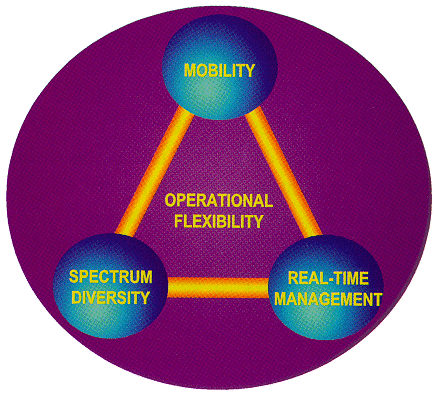
Spectrum Diversity
The electromagnetic spectrum is a finite resource. Every warfighting technology that relies on information transfer, from laser guided bombs to an infantryman's Global Positioning System receiver, operates within the spectrum. DoD SATCOM systems use the spectrum in the very high frequency (VHF), UHF, SHF, and EHF bands. Each band is subdivided into military and civilian portions and provides the warfighter with unique C4I capabilities. All the operational characteristics of one frequency band cannot be duplicated by another. When the capabilities of each portion of the electromagnetic spectrum are combined, the warfighter gains a significant combat multiplier that is less vulnerable to the effects of enemy information warfare. Loss of any portion of the spectrum reduces flexibility, and could jeopardize mission success,
HOW THE WARFIGHTER'S NEED IS SATISFIED TODAY
HISTORY

The evolution of DoD SATCOM has been characterized by development of distinct systems designed to meet the specific needs of individual or groups of users, resulting in a collection of single frequency band-based systems. The existing systems evolved over time, not as the result of a unified plan or architecture, but as a byproduct of the advance of technology. Because of this, systems are often termed "stove piped", i.e., providing separate, unique services to each user group.
MILSATCOM systems have met these individual user group needs well; however, in today's joint warfighting environment interoperability and flexibility must be enhanced. While some current systems support more than one frequency band, they have been primarily designed for users within a single band. The Milstar system is changing this on-orbit segregation to provide true cross-banding between frequencies (EHF to UHF). Nevertheless, most MILSATCOM systems use a single frequency band with interface between systems provided on the ground.
Each frequency band provides a different set of unique characteristics critical to satisfying warfighter communication needs.
Even though there was no integrated vision or overall scheme in their development, until recently the collection of "legacy" systems adequately supplied the needs of DoD users. However, as the need to fight as a joint team has increased, and as the tempo and breadth of the battlefield have expanded, warfighters no longer have the luxury of "stove piped" systems. The separate classes of users have merged.
These users have traditionally turned to a variety of services to meet their combined communications needs. Most of these needs are met by terrestrial means. Communications needs that are satisfied through space fall into two categories of systems: militarily owned and operated systems and commercial leased systems. The choice of system and the relative mix of services provided through these two sources reflects the varying needs of the user and the conditions under which they operate.
MILITARY SATELLITE
COMMUNICATIONS
Combat operations are dynamic warfighters need communications systems that keep pace with real-time battle flow and meet the specific warfighting requirements discussed above. MILSATCOM systems have been designed over the years to do just that. Existing systems use specific portions of the frequency spectrum to provide a range of services for the warfighter.
Spectrum Usage
One of the most critical issues facing communicators is selecting the portion of the electromagnetic spectrum to use. In the civilian world, the choice of spectrum is complicated by a myriad of political and economic, as well as technical considerations, which can take years to negotiate. Each nation reserves the right to control the frequencies within its borders and other spectrum users have the right to demand non-interference with their own systems. Spectrum users reserve frequency for their own benefit by registering their use with appropriate international agencies.
The same basic policy applies to the bands currently used by the MILSATCOM systems. However, the U.S. and its allies jointly allocate certain bands for Government use only. The four bands used by MILSATCOM systems are: VHF, UHF, SHF, and EHF. References to the UHF band are sometimes intended to include the VHF band also.
System Segments
MILSATCOM systems consist of three distinct elements called segments: space, control, and terminal segments. Commercial systems have generally analogous elements, but only the terminal segment is of direct concern to Dol).
Space Segment. The space segment consists of the launch facilities needed to place satellites in orbit and the on-orbit constellation of satellites with their communications payloads.
Launch Facilities. Two major spacelift facilities, the Eastern Range at Cape Canaveral AS, Florida, and the Western Range at Vandenberg AFB, California, are used to launch communications satellites into orbit. Air Force Space Command (AFSPQ operates and maintains both ranges. Geosynchronous orbit communications satellites are launched from Cape Canaveral. Certain polar orbit satellites are launched from Vandenberg. DoD communications satellites are lifted into orbit with medium and heavy launch vehicles.
Satellites. Spacecraft are composed of two functional elements, bus and payload. The bus, made up of the satellite's support subsystems, includes power, attitude control, thermal control, and telemetry, tracking, and commanding (TT&C). The TT&C function includes routine monitoring, adjustment, and anomaly resolution of support subsystems. Payload refers to the primary mission subsystem of the satellite, which, for communications satellites, is the communications subsystem.

Control Segment. The on-orbit operation of military and commercial SATCOM systems requires the support of a ground-based monitoring and control segment. The control segment encompasses those ground elements concerned with spacecraft, payload, and communications network control. Military control responsibilities are divided among the Services and the Defense
Information Systems Agency (DISA). Spacecraft control, sometimes called bus control, is typically a responsibility of the Air Force via the Air Force Satellite Control Network (AFSCN), while payload and network control are performed mostly at system-dedicated facilities. CJCS Memorandum of Policy (MOP) 37, Military Satellite Communications Systems, assigns the various system control responsibilities. Commercial SATCOM control is performed by the system owner/operator, usually by equipping a few ground terminals to perform control functions.
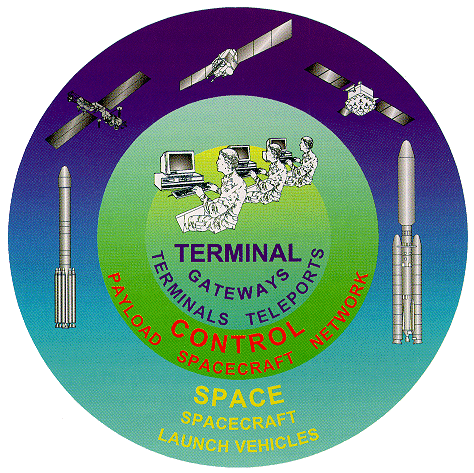
Spacecraft Control. This includes station keeping, stabilization, maneuvering and repositioning, anomaly resolution, TT&C, and ephemeris generation. For most military systems, the AFSCN performs this function from satellite operations centers at Falcon AFB, Colorado through a worldwide network of remote tracking stations.
Payload Control. This function includes planning and executing antenna pointing configurations; transponder gain adjustments; antenna beamweight determinations; transmission security; processor management; crosslink discrimination; anti-jam configuration; and payload commanding. MILSATCOM payload control is performed mainly from system-dedicated control facilities at various locations.
Network Control. This is the technical management of the system's radio frequency spectrum to include power, bandwidth, and frequency allocation. It includes
maintenance of established network parameters and coordination of user accesses and may require changes in satellite configuration and operating modes. Network control is performed from systemdedicated control facilities at various locations.
Terminal Segment. The terminal segment is the complex of ground, airborne, and seabased equipment used for transmitting signals to and receiving signals from communications satellites. Terminals are used for controlling satellites and for accessing and using the payload of communications satellites. Depending on system capabilities, terminals may operate on land-based, sea-based, and air-based platforms such as fixed sites, moving ground vehicles, ships, and aircraft. Terminal equipment ranges in size from those with large fixed antennas to manpack terminals that can be carried and set up for use by one individual.
Gateways and Teleports. Gateways are special ground equipment complexes that serve as a relay between satellites in a SATCOM system. Teleports are equipment complexes that provide interface with the DISN. Teleports permit crossbanding of signals among SATCOM systems operating in different frequency bands and provide a gateway function between SATCOM systems operating at the same frequency.
Ultrahigh Frequency Systems
The most heavily used MILSATCOM systems are those operating in the UHF band. This is true because ground terminals are relatively inexpensive, small, and lightweight. UHF systems can be operated under adverse weather and in dense foliage, and may be used on the move. However, UHF is hampered by its narrow bandwidth (yielding low data rates), and its susceptibility to detection and jamming.
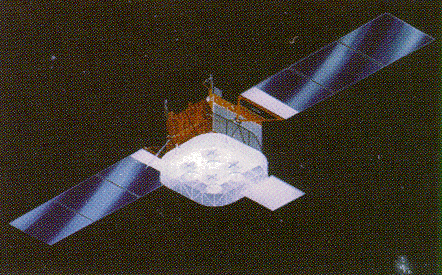
UFO Satellite
UHF is available worldwide through the Fleet Satellite Communications System (FLTSATCOM) consisting of three constellations, Fleet Satellites (FLTSAT), Leased Satellites (LEASAT), and UHF Follow-On (UFO) satellites. Except for UFO, these constellations are nearing or have already surpassed their expected operational lives. In addition, several UHF payloads, collectively known as the Air Force Satellite Communications System (AFSATCOM), are hosted on a variety of constellations to provide SATCOM for strategic users and for north polar region connectivity. Full operational capability for the UFO constellation (eight on-orbit satellites) may be achieved as early as 1997, at which time earlier UHF constellations will be phased out.
Super High Frequency System
The SHF system carries the bulk of MILSATCOM traffic. The 500 megahertz wide band is used to support high data rates with little jam resistance and lower data rates with some limitedjam resistance. The higher frequency permits on-orbit and ground antennas small enough to restrict emissions to specific locations or beamwidths to help avoid detection. SHF service is not routinely disrupted by weather.
SHF service was designed to provide connectivity to large, fixed terminals requiring lower amounts of on7orbit power. As needs have shifted to more tactical, disadvantaged (smaller) terminals, on-board power management has become more critical. SHF terminals are more expensive than UHF terminals. Relatively small terminals have been produced, but are not a practical solution to highly mobile communications needs.

DSCS III Satellite
SHF MILSATCOM is supplied mainly by the Defense Satellite Communications System (DSCS). This five satellite constellation has been in operation since the 1970s. The current assets represent the third generation of DSCS satellites. There are five five more fully built satellites awaiting launch. These will be placed in orbit as the performance of older satellites degrades. The last scheduled launch is anticipated about 2003.
Extremely High Frequency Systems
The Milstar system is ushering in a new era for MILSATCOM. These satellites represent the first on-orbit, large-scale use of the EHF band in support of warfighters, bringing earlier EHF experiments to operational reality. The EHF band provides very wide bandwidth and extremely small, highly directional antennas may be employed. These inherent characteristics allow processed, highly robust signals that are very resistant to the effects of jamming and nuclear scintillation. Terminals may be operated on the move and have a low probability of being detected or intercepted by hostile forces. By decreasing robustness somewhat, even wider bandwidth to allow such features as full-motion video could be achie ' ved. However, the sophisticated technology involved and a small commercial market make EHF terminals significantly more expensive than those in the UHF and SHF bands. EHF communications are also subject to degradation by foliage and heavy rain.

Milstar Satellite
The first two Milstar satellites, the Milstar I constellation, were designed during the Cold War to provide maximum jam resistance and survivability, features that limit the system to voice-grade data rates. Program restructuring in 1992 added a higher capacity payload with data channels in the megabit per second range (medium data rate) to the highly robust low data rate package. This new design, Milstar 11, will be initially launched in 1999, with the full constellation of four geostationary satellites to be. on orbit by 2002. Meanwhile, service will be augmented by low data rate EHF packages on the fourth and later UFO satellites. An EHF capability to serve users in the north polar region is also planned, but has not yet been designed.

COMMERCIAL SATELLITE
COMMUNICATIONS
Current MILSATCOM systems cannot satisfy all requirements under wartime or "surge" conditions. As operations during Desert Storm demonstrated, the need for commercial augmentation of MILSATCOM capabilities is essential.
The DoD began using commercial SATCOM in the late 1960s and remains one of its largest users. During Desert Storm, the DoD used commercial systems to augment its total SATCOM capacity. This capability was especially important in the early stages while military satellites were being repositioned and lower priority users were being off-loaded to other systems. While certain unique MILSATCOM characteristics will continue to be needed for the foreseeable future, the worldwide availability of commercial capacity can reduce the demand for militarily-owned resources.
Commercial Systems
Commercial SATCOM systems operate in the L-band (within the UHF band) and C-band and K-band (within the SHF band).
By convention, commercial frequency use is referred to by these single-letter designations. Generally, commercial SATCOM service is categorized as international (among nations) or domestic (one nation). The primary international systems are operated by the International Telecommunications Satellite Organization (INTELSAT) and the International Maritime Satellite Organization (INMARSAT).
INTELSAT satellites provide unprotected, high capacity links through fixed and transportable terminals.
INTELSAT VII Satellite
(Courtesy COMSAT World Systems)
The INMARSAT constellation supports mobile terminals, especially maritime applications, providing worldwide, openocean coverage. Domestic satellite (DOMSAT) service in the U.S., mostly to fixed site users, is provided by carriers such as GTE Spacenet, AT&T, Hughes Communications Inc., and Alascom Inc. Examples of DOMSATs employed by DoD are Aurora and Galaxy.
DoD Usage of Commercial Systems
The DoD contracts for these services through the Defense Information Technology Contracting Office, but the costs are still rather high, and can quickly deplete scarce operations dollars. For example, during the first two weeks of Operation Restore Democracy in Haiti, the DoD usage of INMARSAT rose by over 100,000 minutes at a cost of $6.25 per minute.
INMARSAT III Satellite
(Courtesy COMSAT Mobile Communications)

Added to these fiscal considerations are operational concerns such as the lack of DoD network control (e.g., to prioritize users), limitedjam resistance, need to negotiate signal "landing rights" in foreign countries, operations at frequencies incompatible with other military terminals, and increased competition with other commercial users for the same channels. Given these constraints, commercial SATCOM cannot satisfy all DoD requirements. However, there are opportunities to make better use of these capabilities where it makes fiscal and operational sense.
As a result of the Commercial Satellite Communications Initiative, the DoD has recently embarked upon a course to do just that. Based on this two year study, the DoD expects to create its own network through the lease of commercial transponders. Contracting directly with the transponder owner, DoD can then establish its own commercial network, over which it retains operational control. While other commercial shortcomings remain, this innovative approach will allow commanders the ability to tailor commercial networks to best suit changing conditions, off-load lower priority users, and manage commercial/ military traffic to the best operational advantage. By using this approach, the DoD can expect greater access to commercial communications capacity at reduced cost with an increased ability to control the operational use of those resources.

ALLIED NATION SATCOM SYSTEMS
The U.S. has treaties and agreements with its allies for DoD use of various SATCOM systems. As a member of the North Atlantic Treaty Organization (NATO) alliance, the U.S. has access to the NATO communications satellites. Agreements permit DoD use of the United Kingdom's Skynet system and France's Syracuse satellites. These systems operate in the UHF and SHF bands and are a primary means of communications interoperability between U.S. and allied nation forces. The principal U.S. military users are deployable forces using tactical transportable terminals.
NATO III Satellite
MANAGEMENT OF DOD SATCOM SYSTEMS
MANAGEMENT STRUCTURE.
The Secretary of Defense has assigned to the Assistant Secretary of Defense (ASD) for C31 responsibility for overall DoD SATCOM policy, program, and planning guidance and direction, architecture and acquisition roadmap approval, and Planning, Programming, and Budgeting System focus for the DoD).
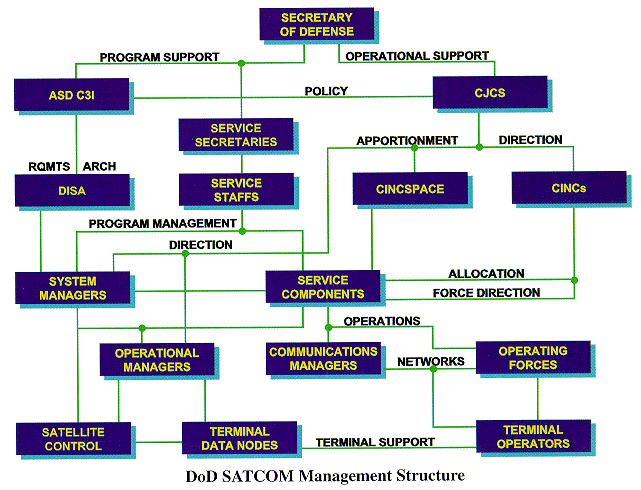
CKS MOP 37 OBJECTIVES AND POLICY
The objective of CJCS MOP 37 is to ensure DoD SATCOM support for operational missions. It establishes a standard process to identify and validate connectivity requirements. It outlines procedures for optimizing allocation of and access to DoD SATCOM resources. It directs the development and maintenance of a DoD SATCOM architecture and acquisition roadmap, and a joint approach to planning, programming, and budgeting. It supports design of systems that address user operational needs, provides interoperability among users, and provides necessary survivability.
DoD SATCOM systems are used for day-to-day operations, for the execution of operational plans, and as directed by the National Command Authorities. Systems are controlled as joint assets and the basic allocation of resources is addressed through the deliberate planning process. Interoperability and standardization among U.S. forces and allies are essential considerations in DoD SATCOM planning and development. Standardization of operational management and control of systems is required by CJCS MOP 37. Compliance with DoD SATCOM technical standards by users is required before access is granted.
DoD SATCOM RESPONSIBILITIES.
Many agencies are involved in managing each DoD SATCOM system. These include Commander in Chief, United States Space Command (USCINCSPACE), the other Commanders in Chief (CINCs), DISA, the Services, the National Aeronautics and Space Administration, and commercial carriers. No one agency or Service has complete responsibility for a DoD SATCOM system. For example, the Navy and Air Force identified and defined the requirements for the FLTSATCOM System. The Air Force acquired and launched the satellites, and provides spacecraft control. The Navy controls the payload and networks and the Services procure UHF terminals compatible with FLTSATCOM.
The CJCS and the Joint Staff
The CJCS establishes doctrine, policy, guidelines, and procedures for the use of all DoD SATCOM systems. The CJCS has final authority for DoD SATCOM requirements approval, MILSATCOM system configuration, and MILSATCOM capacity apportionment. The Joint Staff identifies and assigns responsibilities and the scope of authority for MILSATCOM system managers and operational managers.
Joint Communications Satellite Center

The focal point for Joint Staff operational direction of DoD SATCOM systems is the Joint Communications Satellite Center (JCSC). The JCSC chairs the Joint MILSATCOM Panel and interacts with the staffs of the CINCs, Services, system operational managers, and other agencies to coordinate actions requiring CJCS approval or adjudication.
Commanders in Chief
CINCs and their staffs are responsible for allocating assigned MILSATCOM capacity to support operations in their assigned areas of responsibility. CINCs gather requirements from their component commands, validate them, and forward them to the Joint Staff for approval. The CJCS has approval authority for all DoD SATCOM requirements and apportions MILSATCOM capacity to each CINC for allocation to subordinate forces.
Commander in Chief, United States Space Command
USCINCSPACE has combatant command authority for MILSATCOM assets through service component commanders. This authority includes planning and ~ operating MILSATCOM constellations, and executing satellite, constellation, and payload reconfiguration. Air Force Space Command (14th Air Force), Naval Space Command, and Army Space Command are the United States Space Command (USSPACECOM) components responsible for operational control of MILSATCOM satellite, network, and payload operations.
System Managers and System Operational Managers
The Services and DISA serve as system managers for individual systems. System managers designate system operational managers to perform day-to-day operations. Except for DISA, system managers are responsible for programming funds, advocating and acquiring systems, and managing system funds. System operational managers develop system control and operations concepts (SCOC), define system architectures, develop capacity allocation procedures, and perform day-to-day management of systems.
DOD SATCOM OPERATIONAL REQUIREMENTS PROCESS.
CJCS MOP 37 contains procedures for submission and validation of DoD SATCOM requirements. MILSATCOM, commercial, and allied nation SATCOM requirements all must be submitted. Commercial SATCOM services are procured through each Service's commercial communications leasing procedures. DoD SATCOM requirements originate with the component warfighting commands through their CINC, and with the Joint Chiefs of Staff (JCS), Services and DoD agencies through the CJCS. The Joint MILSATCOM Panel submits these requirements to a technical assessment, review and approval process.
Approved requirements are listed in the JCS-validated Integrated Communications Database (ICDB). Every two years, the JCSC conducts a review of the ICDB to ensure that all requirements remain valid. Also, USSPACECOM conducts a periodic space assessment based on the warfighting CINCs' operational requirements.
A validated requirement in the ICDB does not guarantee system access. The full set of validated requirements for any MILSATCOM system cannot be satisfied simultaneously. Thus, procedures are necessary to ensure that higher priority operational needs are met. Access requests must be submitted to the system operational managers according to SCOC procedures. Basic allocation of MILSATCOM resources occurs through the deliberate planning process, but dynamic reallocation may be necessary due to rapid changes in the operational environment. Competing
THE FUTURE DOD SATCOM ARCHITECTURE
FOUNDATION FOR THE FUTURE
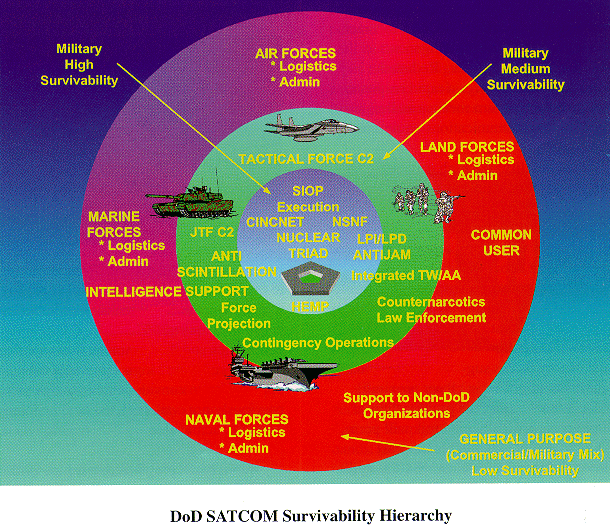
Warfighting requirements must be the foundation upon which a future
DoD SATCOM capability will be built. Under the most realistic assumptions,
requirements will continue to grow at rates rivaling the growth of information
needs in the commercial world. Force projection and deployment strategies,
unpredictable locations of conflict, and lack of a modern infrastructure
in potential conflict areas place greater demands upon SATCOM than ever
before. With the end of the Cold War,
the threat to SATCOM has decreased. However, threat technology is now readily available to any nation. No two users have identical communications needs and their differing operational environments call for solutions designed with as much flexibility as possible. The warfighter's need for SATCOM spans the spectrum of conflict, from high to low survivability. It is likely that no single solution can meet all these needs. The DoD will have to field a range of services to properly supply the satellite communications needs of our future force.
PRIMARY CONSIDERATIONS
The U.S. must have assured access to satellite communications capacity. This means having access to adequate capacity when and where it is needed anywhere in the world. Although commercial communications can provide an important and useful capability, DoD can not depend on it solely since there will be circumstances where its use could be delayed or denied for political or other reasons. Therefore, militarily-owned systems are needed which reserve their capacity to provide assured access to the deployed warfighter.
The U.S. is moving from forward basing of forces and support to a CONUS-based strategy. This will lead to more dependence by deployed forces on SATCOM for "reachback" to CONUS-based intelligence, logistics, and other support. Reduced forward presence requires a rapid response capability which in turn means smaller, highly mobile communications equipment.
The availability of a high capacity terrestrial network should permit the DoD to off-load much of its fixed site to fixed site high data rate traffic from militarily-owned satellites. This will permit those satellites to be used to meet needs that cannot be satisfied by any other means.
The nonlinear nature of the battlefield with U.S. forces moving rapidly in and around enemy forces suggests that terminals and jammers might be in closer proximity. Rapid advances in and the proliferation of technology on a worldwide basis will permit the DoD to acquire smaller, lower cost satellites and terminals. However, the same circumstance will permit potential adversaries, even less sophisticated ones, to acquire satellite uplink jamming equipment.
When complete, the currently programmed architecture will be comprised of eight UFO, five DSCS 111, and four Milstar 11 satellites. This will not satisfy the projected capacity needs for a two MRC scenario. Assuming a maximum off-load to commercial SATCOM or terrestrial optical fiber, projected capacity needs are still about 600 megabits per second of robust access low/medium data rate service, and two to three gigabits per second of assured access medium/high data rate service. The future architecture must account for these capacity increases. Ironically as the requirement for information virtually explodes, resources that can be applied to the need are dramatically decreasing. A future DoD SATCOM architecture should be structured to be as flexible as possible while recognizing the fiscal realities under which it will be acquired. The change in world geopolitics and the commercial availability of advanced technologies provides the opportunity to consider solutions that were previously not contemplated, and in some cases not achievable.
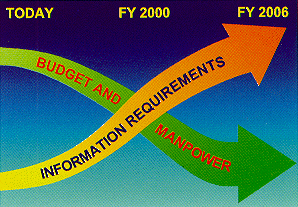
Properly accomplished, a future DoD SATCOM architecture will be able to meet the evolving needs but at a reduced cost when compared to our current systems.
This emerging approach to a future architecture reflects the warfighter's traditional concerns as well as a revised outlook on how the DoD can best supply the required service.
PROVISION OF SERVICES
This new architecture will, provide the required service through the three avenues discussed below.
Commercial Service
This is the appropriate choice when it is technically possible to provide the required services in an operationally acceptable manner. It may also be less expensive compared to using a militarily-owned system. This is normally the ideal solution for fixed users whose locations and longterm needs are well known and predictable.
Commercial Acquired, Military Owned
USE OF THE SPECTRUM
A critical decision that must be made for developing a future architecture is selecting the frequency bands. The DoD currently uses three primary bands, for MILSATCOM: UHF (and VHF), SHF, and EHF. One possibility is to reduce usage to fewer bands, thus conceivably reducing the number of on-orbit resources required, as well as the number of different terminal types needed. Significant savings could be accrued in control segments, network management activities, and depot support operations.
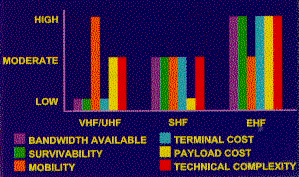
However, each frequency band brings certain advantages to the operational user that are simply not available in the other bands. For example, while the tactical utility of UHF can almost be replicated at EHF (although mobility and adverse weather use both suffer), the cost of such a trade would be prohibitive, given the installed baseline of over 15,000 UHF terminals and the cost of EHF terminals ($300,000 and up). Likewise, while some military SHF band users could potentially be serviced by commercial C-band or Ku-band, the problems inherent in commercial systems (aside from purely fiscal arguments) preclude this from being more than a supplement to a militarily-owned SHF capability. It is therefore clear that the future SATCOM architecture will continue to employ all three of the currently used frequency bands. While the absolute proportions will likely change, the DoD will not move away completely from any of the presently used communications bands.
CONSTELLATION PLANNING
The future SATCOM architecture will likely consist of a number of on-orbit constellations, some procured commercially and others procured using nominal DoD processes, each providing service in one or more frequency bands. The mixture of services provided on a single platform, the number of satellites flown, and the size of the individual satellites will determine the architecture's cost and the flexibility it has to meet the users requirement.
Constellation Size/Satellite Number
When the current systems are fully mature they will consist of eight UFO, five DSCS, and four Milstar II satellites. These numbers do not include partially capable satellites that may still be operable. An architecture with fewer satellites could be more cost effective, not only because of the high cost of launching assets to space, but also because larger constellations (a greater number of individual satellites) result in a higher proportion of satellite bus structure to communications payload and higher ground based control costs. This consideration would drive the architecture to larger, more capable satellites.
However, fewer large satellites, for example a constellation of four large satellites each supporting all three frequencies, is inherently less flexible. On orbit assets could not be repositioned independently, effectively tying geographic coverage of one frequency to the other two. In addition, it would be difficult to simply replenish or add to a single band's capacity. Finally, a single launch failure would represent a much greater capability loss.
Launch Vehicles
Constellation Conclusions
Given these dynamics, it should be possible to consolidate two of the three types of services (UHF, SHF, EHF) on a single platform. This merging of the "stove pipes" would limit the number of on-orbit assets while maintaining sufficient flexibility among systems. The mixture of services could be dictated by relative need dates, similar community of users, or compatibility of probable acquisition strategies. While it is assumed that the size of the individual systems could be constrained to a medium-sized payload, future decisions would be based upon the most cost-effective approach.
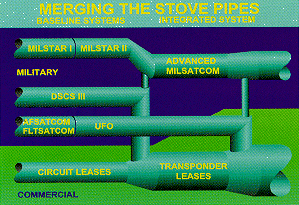
ADDITIONAL SERVICES
Apart from the mainstream UHF/SHF/ EHF services discussed above, other services will be required in the future DoD SATCOM architecture. Two of these are communications in the north polar region and global broadcast service.
Polar Communications
Communications coverage in the north polar region requires satellites that are in highly inclined orbits. While the bulk of required communications is in the lower latitudes, a limited amount of high priority communications are needed north of the Arctic Circle. These requirements can be met in several ways, for example, smaller packages deployed on other host satellites already slated for highly inclined orbits (as is done today for AFSATCOM packages), or perhaps dedicated satellites. Whatever polar communications solution is selected, these services must interoperate seamlessly with the primary constellations.
Global Broadcast Service
As we examine the emerging DoD SATCOM requirements, becomes clear that a large percentage of these are of a different character from the communications serviced by the existing architecture. A significant emerging military requirement is one-way, high-volume transmission of information to the warfighter. This need is now referred to as global broadcast service, similar to commercial direct broadcast service. Transfer of predominantly one-way data flows from the heavily used two-way systems is potentially very useful in the future DoD architecture.
TRANSITIONING TO THE FUTURE ARCHITECTURE
While the future architecture will be judged primarily on the basis of how well it addresses the warfighter's long range requirements and how cost effectively it does so, it will also be evaluated for how well it fuses with the current architecture. Planners must consider the legacy systems in developing the future DoD architecture. Moving from the systems of today to the constellations of tomorrow must be carefully orchestrated. Otherwise, the expected savings will not materialize. Three major issues must be considered:

NEED DATES
Satellites are designed with a given life expectancy. A prime criterion for a space vehicle in its design is its service life and its mean mission duration (MMD). This MMD can be limited by the redundancy of its components, the onboard fuel stores, or the capacity of its energy generation system. In practice, and neglecting early failure, a satellite system often provides acceptable performance beyond its MMD, although usually at reduced performance. While the MMD for a satellite is physically constrained by its weight and radiation environment, it may also be intentionally limited by its designers in terms of its cost and planned technology upgrades.
The three constellations that will be in orbit into the next century are being launched at different times, have different MMI)s and, as a result, different replenishment need dates. Based upon their current schedules, the first constellation that will need replenishment or replacement will be the Milstar constellation, beginning in the year 2003 or 2004. The DSCS constellation will also require replenishment by 2003- 2004, although DSCS is being evaluated for a service life extension program that would move its replenishment date out beyond 2004. The UFO constellation is due for replenishment by 2005-2006. The need dates are based on Generalized Availability Program runs and are being studied by the MILSATCOM Integrated Product Team and the DoD Space Architect. The dates present two challenges:
These considerations affect the future DoD SATCOM architecture and the strategies the DoD must pursue to manage the transition. For example, if the Department decided to field a combined UHF/SHF satellite it would be necessary to extend the life of the DSCS constellation. Consolidating the EHF/SHF segment could require forgoing the DSCS life extension program. Each architecture decision will have a different impact on the need date analysis and eventual course the DoD takes.
ACQUISITION STRATEGIES
Until recently, all DoD communications satellites were acquired in a similar manner through a process like the one detailed in DoD Directive 5000. 1, Defense Acquisition. However, for the UFO satellites, the Navy used a procurement approach similar to the one used in the commercial satellite industry. It defined the functional requirements for the satellites and contracted for them to be delivered on-orbit at a fixed price.
Just as the use of leased commercial services might lower the cost of communications for the DoD, so too could the use of a "commercial" acquisition approach. However, the commercial approach is not applicable to all system acquisitions.
Defense Acquisition
DoD Directive 5000.1 describes a milestone-driven process for the development and acquisition of military systems. Its intent is to ensure that fielded systems live up to the requirements against which they were designed and that they do it at the best price for taxpayers. The process is well suited to the acquisition of highly specialized military equipment (for which there is no commercial equivalent) or for systems that push beyond the state-of-the-art in design. This applied to most MILSATCOM systems deployed to date, both for the technology employed (e.g., nuclear hardened electronics) and the communications capabilities required.
Today the situation is different. The capabilities of many on-orbit commercial satellites are similar to the capabilities required by military users. Of the three military frequency regimes, only EHF capability is clearly beyond current commercial technology. However, commercial demand could quickly change this. Other individual subsystems, such as esoteric antenna technology, may stress commercial development for the more common frequency bands, but only EHF technology remains distinct. This is especially true for the next generation of EHF technology that must be improved dramatically to meet the requirements expected in the next decade. This fact restricts advanced technology EHF satellites to the development path historically employed. Nevertheless, recent streamlining initiatives in DoD acquisition should hasten the overall process, while reducing costs.
Commercial Acquisition
Commercial acquisition means buying satellites with similar business practices used by commercial companies. It is differentiated from the leasing of commercial services because the DoD would own and control the on-orbit resources. As discussed earlier, many deployed warfighter requirements can not be satisfied by commercial leases simply because there is no economical way to assure access to the services when and where they are required. A system purchased as if the DoD were a commercial buyer has the potential to meet the SATCOM need for many deployed warfighters.
Commercial practices mean acquiring a satellite with minimal government oversight, in most cases on a firm fixed price contract. This approach can be used to satisfy those needs that can be met through minor modification of existing commercial satellite designs or with technology that has been commercially proven. This kind of procurement might be appropriate for UHF or SHF space segments as well as any new service that has a commercial equivalent, e.g., global broadcast service.
REQUIREMENTS MODERATION
In the past, MILSATCOM services have been supplied "free" to users while commercial services were provided on a cost-reimbursable basis. This difference seemed to have the effect of limiting the growth of commercial usage, while creating an increased demand for scarce MILSATCOM system resources. Requirements for those systems increased, apparently, only at the expense of the DoD component providing the service, not at the expense of the originator. The disconnect between system costs and operational benefit appeared to make it difficult to control the baseline requirements and capabilities for the system.
This historical picture is rendered less clear by actual experience. In the past, each DoD component shared, to an extent, the cost of MILSATCOM systems either directly, in the cost of deploying a system (e.g., the Navy acquired the UFO satellites), or through the required purchase of satellite terminals and ground infrastructure. Terminals and ground infrastructure have a life-cycle cost nearly double that of the space segment. Additionally, since 1984 it has been the CINCs of the unified commands who have been responsible for
the generation of communications requirements. These commands are joint, i.e., not attached to any single military service. These factors add complexity to the problem of allocating costs for MILSATCOM systems to individual services. Where practical, it is DoD's intent to identify specific fiscal implications of SATCOM requirements and to allocate the cost of satisfying those requirements to the component or components. in proportion to their benefit received.
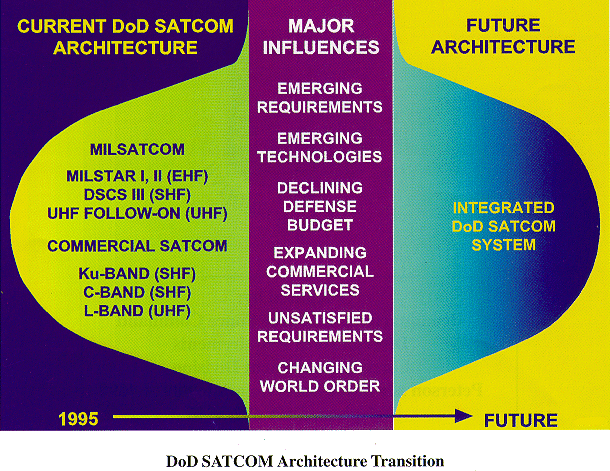
DoD SATCOM requirements are anticipated to increase dramatically in the next decade. The information explosion, CONUS-based force structure, and far-flung operations all will stress DoD's ability to provide uninterrupted connectivity to the warfighter. Other major influences include a changing world order, declining defense budgets, and emerging SATCOM technologies. The aim of the future architecture is to greatly increase both the capacity and capability of SATCOM services while reducing the overall costs compared to the cost of the current architecture. The integrated DoD SATCOM system will include a mix of militarily acquired and commercially acquired, DoD owned systems, as well as commercial leased services managed by DoD for fixed users and to augment DoD owned resources.
DoD SPACE REORGANIZATION
The Secretary of Defense determined that organizational changes were necessary to significantly improve the DoD's ability to field affordable space capabilities that meet warfighters' most pressing needs. Secretary Perry has established the office of Deputy Under Secretary of Defense for Space DUSD (Space)] reporting to the Under Secretary of Defense for Acquisition and Technology. The position of DoD Space Architect, to be aligned under the Air Force Acquisition Executive, has also been established. The DUSD (Space) will be the DoD focal point for all space matters and will develop, coordinate, and oversee implementation of DoD policy for space activities. The office will oversee space acquisition programs and architectures and will be the principal DoD staff support for the Joint Space Management Board. The principal role of the Space Architect will be to develop a DoD space architecture to be accomplished through close interaction with requirers, users, and acquirers. The Architect will be the focal point for military, civil, and intelligence space architecture integration and will interface with the DUSD (Space), USSPACECOM, the Services, CINCs, agencies, and other space organizations.

WINDOW OF OPPORTUNITY
There is an immediate need to make far reaching decisions regarding
replacement of the current MILSATCOM systems. This presents a unique window
of opportunity for the DoD to develop an overarching SATCOM architecture
and acquisition roadmap to deploy a DoD SATCOM System that is seamlessly
integrated with the DISN. This effort will require the full technical and
budgetary cooperation of all the Services and DoD agencies involved with
SATCOM.